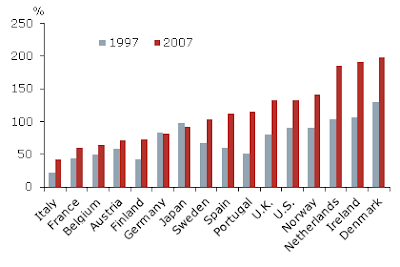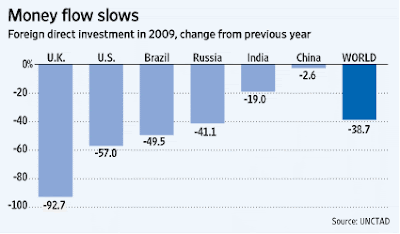On Bank Bashing
Here are two opposite views from two of my favorite:
Stephen Roach, Chairman of Morgan Stanley Asia:
Bob Reich, former Labor Secretary under Clinton Administration, professor at Brandeis University and now at UC Berkeley.
Why Obama must take on Wall Street
China to launch foreign stock ETF
China has some innovative ways to diversify its huge foreign reserves. I am very happy to see China did not stop its reform in financial sectors in the aftermath of financial crisis, rather the pace has sped up.
The Shanghai Stock Exchange, in an effort to expand ties to overseas markets, will launch China’s first exchange-traded fund tracking foreign stocks this year, SSE president Zhang Yujun said on Thursday. The announcement follows local media reports that the SSE will allow Chinese fund companies to develop global ETFs to track overseas indices such as the Dow Jones Industrial Average. It also comes amid expectations that Beijing will finally allow foreign companies to list in Shanghai this year.
Household leverage and house prices
The higher the leverage ratio a country’s household has, the higher increase of house prices; and when bubble bursts, the sharper the price decline.
I am very surprised to find out Denmark (the country I am currently living in) has the highest household leverage ratio. Faint!
The stage of irrational exuberance:
Days of Reckoning:
No more proprietary trading?
The White House wants commercial banks that take deposits from customers to be barred from investing on behalf of the bank itself—what's known as proprietary trading—and said the administration will seek new limits on the size and concentration of financial institutions.
"You can choose to engage in proprietary trading, or you can own a bank, but you can't do both," the official said.
Larry Summers on innovation economy
Larry Summers on the future of innovation, and what are the challenges faced by the US from China and India, and how the US should respond.
Innovation and Economic Growth from Innovation Economy on Vimeo.
Those investment fools
A reality check on long-term investing, from Jason Zweig:
What are we smoking, and when will we stop?
A nationwide survey last year found that investors expect the U.S. stock market to return an annual average of 13.7% over the next 10 years.
Robert Veres, editor of the Inside Information financial-planning newsletter, recently asked his subscribers to estimate long-term future stock returns after inflation, expenses and taxes, what I call a “net-net-net” return. Several dozen leading financial advisers responded. Although some didn’t subtract taxes, the average answer was 6%. A few went as high as 9%.
We all should be so lucky. Historically, inflation has eaten away three percentage points of return a year. Investment expenses and taxes each have cut returns by roughly one to two percentage points a year. All told, those costs reduce annual returns by five to seven points.
So, in order to earn 6% for clients after inflation, fees and taxes, these financial planners will somehow have to pick investments that generate 11% or 13% a year before costs. Where will they find such huge gains? Since 1926, according to Ibbotson Associates, U.S. stocks have earned an annual average of 9.8%. Their long-term, net-net-net return is under 4%.
All other major assets earned even less. If, like most people, you mix in some bonds and cash, your net-net-net is likely to be more like 2%.
The faith in fancifully high returns isn’t just a harmless fairy tale. It leads many people to save too little, in hopes that the markets will bail them out. It leaves others to chase hot performance that cannot last. The end result of fairy-tale expectations, whether you invest for yourself or with the help of a financial adviser, will be a huge shortfall in wealth late in life, and more years working rather than putting your feet up in retirement.
Even the biggest investors are too optimistic. David Salem is president of the Investment Fund for Foundations, which manages $8 billion for more than 700 nonprofits. Mr. Salem periodically asks trustees and investment officers of these charities to imagine they can swap all their assets in exchange for a contract that guarantees them a risk-free return for the next 50 years, while also satisfying their current spending needs. Then he asks them what minimal rate of return, after inflation and all fees, they would accept in such a swap.
In Mr. Salem’s latest survey, the average response was 7.4%. One-sixth of his participants refused to swap for any return lower than 10%.
The first time Mr. Salem surveyed his group, in the fall of 2007, one person wanted 22%, a return that, over 50 years, would turn $100,000 into $2.1 billion.
Does that investor really think he can get 22% on his own? Apparently so, or he would have agreed to the swap at a lower rate.
I asked several investing experts what guaranteed net-net-net return they would accept to swap out their own assets. William Bernstein of Efficient Frontier Advisors would take 4%. Laurence Siegel, a consultant and former head of investment research at the Ford Foundation: 3%. John C. Bogle, founder of the Vanguard Group of mutual funds: 2.5%. Elroy Dimson of London Business School, an expert on the history of market returns: 0.5%.
Meanwhile, I asked Mr. Salem, who says he would swap at 5%, to see if he could get anyone on Wall Street to call his bluff. In exchange for a basket of 51% global stocks, 26% bonds, 13% cash and 5% each in commodities and real estate—much like a portfolio Mr. Salem oversees—the institutional trading desk at one major investment bank was willing to offer a guaranteed rate, after fees and inflation, of 1%.
All this suggests a useful reality check. If your financial planner says he can earn you 6% annually, net-net-net, tell him you’ll take it, right now, upfront. In fact, tell him you’ll take 5% and he can keep the difference. In exchange, you will sell him your entire portfolio at its current market value. You’ve just offered him the functional equivalent of what Wall Street calls a total-return swap.
Unless he’s a fool or a crook, he probably will decline your offer. If he’s honest, he should admit that he can’t get sufficient returns to honor the swap.
So make him explain what rate he would be willing to pay if he actually had to execute a total return swap with you. That’s the number you both should use to estimate the returns on your portfolio.








![Reblog this post [with Zemanta]](https://img.zemanta.com/reblog_e.png?x-id=4077ae49-5eff-4e97-8e93-2f0605c1bfae)